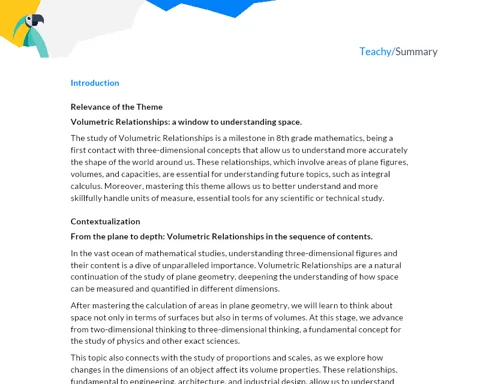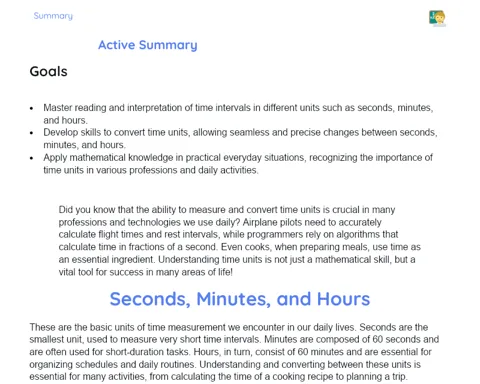TOPICS: Triangles - Cevians and Notable Points
Keywords
- Cevians
- Altitude
- Median
- Bisector
- Orthocenter
- Incenter
- Centroid
- Circumcenter
Key Questions
- What are cevians and why are they important in triangles?
- What are the differences between altitude, median, and bisector?
- How are notable points located in a triangle?
- What is the relationship between cevians and the triangle's notable points?
Crucial Topics
- Definition of cevian
- Characteristics of altitude, median, and bisector
- Properties of notable points: orthocenter, incenter, centroid, and circumcenter
- Methods of constructing cevians
- Practical applications of notable points
Specificities by Areas of Knowledge
Meanings
- Cevian: line segment that starts from a vertex and meets the opposite side or its extension.
- Altitude: cevian perpendicular to the opposite side, crucial for area calculations.
- Median: cevian that connects a vertex to the midpoint of the opposite side, indicating the center of mass.
- Bisector: cevian that divides an angle into two equal angles, important in proportionality.
Formulas
- Stewart's relation for medians: (d^2 = \frac{2b^2 + 2c^2 - a^2}{4}), where d is the median, and a, b, c are the sides.
- Area formula using altitudes: (Area = \frac{base \cdot altitude}{2}).
- Law of sines to locate the incenter: (\frac{a}{\sin(\alpha)} = \frac{b}{\sin(\beta)} = \frac{c}{\sin(\gamma)} = 2R), where R is the radius of the circumcenter.
NOTES: Cevians and Notable Points - Detailed Exploration
Key Terms
- Cevians: Line segments that connect the vertices of a triangle to the opposite sides. They are essential for understanding the internal structure of triangles and are used to define notable points.
- Altitude: Crucial in area calculation formulas, the altitude of a triangle is the cevian that goes from a vertex to the opposite side forming a right angle.
- Median: Cevian that acts as a symmetry axis, dividing the triangle into two equal area parts. Connects a vertex to the midpoint of the opposite side.
- Bisector: Cevian that divides one of the triangle's angles into two equal parts, is fundamental in the analysis of proportionality between segments.
Main Ideas and Concepts
- Cevians are vital for understanding how notable points are determined.
- Altitudes, medians, and bisectors reveal symmetrical properties and provide information about angular and distance relationships within the triangle.
- Notable points are unique: each triangle has a single orthocenter, incenter, etc.
Topic Contents
- Definition and Properties of Cevians:
- Cevians are internal lines that present a variety of properties depending on their typology.
- The interaction between different cevians, such as medians, can reveal the triangle's center of mass (centroid).
- Construction of Cevians:
- Altitudes are constructed by drawing a perpendicular line from the vertex to the opposite side.
- Medians connect each vertex with the midpoint of the opposite side.
- Bisectors are constructed by dividing the internal angles of the triangle into two equal parts.
- Resulting Notable Points from Cevians:
- Orthocenter (H): The point where the three altitudes meet.
- Centroid (G): The intersection point of the three medians, which is also the center of gravity of the triangle.
- Incenter (I): The point where the three internal bisectors meet, and also the center of the inscribed circle.
- Circumcenter (O): The intersection point of the side medians, being the center of the circumscribed circle.
Examples and Cases
- Area calculation using altitudes:
- Given a triangle with base b and altitude h, the area is A = (b * h) / 2.
- Locating the Centroid:
- To locate the centroid G, draw the medians of a triangle. The centroid will be the point where they intersect.
- Using the Bisector in Proportionality Problems:
- If an internal bisector is drawn from a vertex A to the opposite side BC, it divides the side BC into segments that are proportional to the other two sides of the triangle.
- Determining the Circumcenter:
- Construct the medians of each side of the triangle. The point where they meet is the circumcenter.
SUMMARY: Overview of Cevians and Notable Points
Summary of the most relevant points
- Cevians are line segments that connect vertices to opposite sides, fundamental for the structural analysis of triangles.
- Altitudes allow area calculation and define the orthocenter (H).
- Medians point to the centroid (G), center of mass and balance of the triangle.
- Bisectors are key to proportionality problems and locate the incenter (I), center of the inscribed circle.
- The Circumcenter (O) is defined by the meeting of the medians, being the center of the circumscribed circle.
Conclusions
- Each cevian has its unique applicability, revealing different characteristics and properties of triangles.
- Notable points result from the specific intersection of cevians and are essential for understanding the geometric aspects and symmetry of triangles.
- Understanding the construction and intersection of cevians expands the ability to solve complex geometric problems, including area calculations, center location, and proportionality analysis.
- The symmetry and proportional relationships intrinsic in cevians are the basis for various practical applications, from pure mathematics to engineering and architecture.



